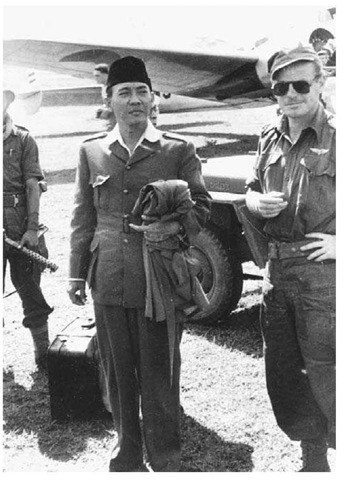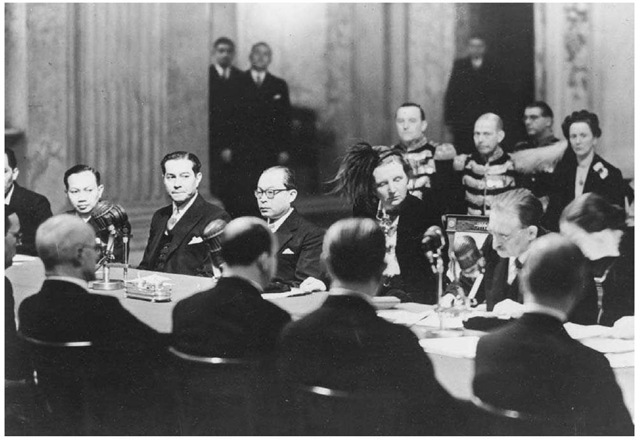The Indonesian Revolution took place immediately after the Japanese surrender in World War II on August 15, 1945, lasted until the end of that year, and was in part political and in part social. The revolution had been in the making for years. Before the war the expanding colonial state not only educated a modern Indonesian elite that started to strive for a more democratic colonial government, it also modernized Indonesian society, which undermined the power and influence of traditional aristocratic rulers who used to be the most important allies of the colonial state. However, in response to the wishes of the modern Indonesian elite, the Dutch colonial government only halfheartedly introduced a few semidemocratic institutions and stuck to its traditional allies. The leaders of the Indonesian nationalist movement were, with a few exceptions, imprisoned or banned to a small number of peripheral places in the archipelago.
World War II shook the already weakened foundations of the Dutch colonial state. The ease with which the Japanese army defeated Dutch colonial forces and occupied the Dutch East Indies fundamentally altered the way Indonesians perceived Dutch power in the archipelago. The prestige upon which colonial rule rested had disappeared. Second, during the Japanese occupation, Dutch officials and civilians were interned in prison camps and virtually disappeared in Indonesian society. Third, and most importantly, Japanese authorities mobilized the Indonesian population on Java. The most influential nationalist leader, Soekarno (1901-1970), was brought out of internment to Java and was allowed to address the Javanese people. Javanese youth were trained in a semi-military fashion and organized in paramilitary organizations.
As the war progressed, the Javanese pemuda (youth) increasingly took a radical and independent position toward the Japanese and also toward the issue of Indonesian independence. In response, Japanese authorities promised Indonesia a degree of independence. They created the Badan Penjelidik Oesaha-Oesaha Persiapan Kemerdekaan (Committee to Investigate Independence), which came together for the first time in Jakarta in May 1945. During the meetings of this committee, Sukarno formulated his doctrine of Pancasila (Five Principles), the state ideology of independent Indonesia: nationalism, humaneness, democracy, social justice, and belief in one God. However, it took until August 7, 1945, before the Japanese authorities allowed the establishment of the Panitia Persiapan Kemerdekaan Indonesia, the committee to prepare actual Indonesian independence.
Achmed Sukarno (1902-1970). The Indonesian nationalist leader, statesman, and president, photographed on January 4, 1949.
This meant that on the day of Japan’s surrender in 1945, nothing was arranged with regard to a possible independence of Indonesia. The main nationalist leaders, Sukarno and Mohammad Hatta (1902-1980), were very much surprised by the sudden collapse of the Japanese Empire and had no clear ideas on how to proceed further. However, for many Indonesian pemuda it was obvious that the time had come for Indonesia to declare itself fully independent on its own terms. When Sukarno and Hatta reacted with hesitancy, they were kidnapped by angry pemuda and brought to army barracks east of Jakarta. The pemuda expected an uprising by the population of the capital, but when this uprising did not materialize, they returned Sukarno and Hatta to the city. There, the Japanese admiral Tadashi Maeda promised not to interfere when Sukarno and Hatta proclaimed the independence of Indonesia.
Under pressure from the pemuda and with the assurances of the Japanese authorities in Jakarta, Sukarno and Hatta wrote a short declaration of independence, which on August 17, 1945, Sukarno read in front of his house at the Jalan Pegangsaan Timur: ”We, the people of Indonesia, declare the independence of Indonesia. All matters regarding the transition of power will be dealt with in an orderly fashion and as soon as possible.” A day later, a makeshift parliament adopted a constitution and elected Sukarno to be the first president of the Republic of Indonesia and Hatta to be the first vice president. However, at that moment, the Republic of Indonesia existed only on paper, without an effective bureaucracy or powerful police and security forces.
In the meantime, the old colonial power, the Netherlands, had no means to respond to the events in Indonesia. The Dutch not only lacked military forces in the region, formal power on Sumatra and Java was in the hands of the British supreme commander in Southeast Asia, Admiral Lord Louis Mountbatten (1900-1979). Mountbatten was convinced that Asian nationalism was a force to be reckoned with. Therefore, he left the countryside to the Republic of Indonesia and deployed his forces only in a few important cities along the coast, with the aim of transporting Japanese forces out of the country and of helping imprisoned and interned European military and civilians. As August progressed, this project became more and more difficult due to a rising revolutionary fever among the Indonesian people. When Dutch Lieutenant Governor-general H. J. van Mook (18941965) returned to Batavia—as he knew Jakarta—on October 2, 1945, he had to conclude that the situation for the Dutch was much worse than he had expected.
From the start of October onward, the Indonesian Revolution became a chaotic and bloody affair. The disappearance of the Japanese, the arrival of Allied forces, and the return of some of the Dutch from imprisonment or internment to their houses, resulted in attacks on Dutch civilians and property. Dutch houses were searched, and Dutch and Indo-European citizens were executed under the cry siaaap! (be prepared). The period became known as the Bersiap period.
The situation for the Dutch became even more difficult when Indonesians started an economic boycott against them on October 13. However, most frightening for the Dutch were the radical pemuda, who roamed the streets, raped women, and killed as they pleased. They not only targeted the Dutch, but also Chinese citizens who did not join the anti-Dutch economic boycott. In addition, Indonesians who cooperated with the Dutch, such as Ambonese and Menadonese members of the Dutch colonial army, were also attacked, resulting in bloody revenge from their side. It is not known how many people died during the Bersiap period. An estimated 3,500 Dutch were killed, but many others went missing.
In the Javanese countryside, the rage of the pemuda was directed against the members of the aristocratic elite who before the war had cooperated with the Dutch colonial rulers. In western Java, a revolutionary council took power and jailed the old elite. In central Java, in particular in the regency of Pekalongan, the same happened during the so-called Tiga Daerah Affair—or ”Three Regencies Affair”. Village chiefs, districts leaders, police officers, Chinese, and Indo-Europeans were attacked, kidnapped, imprisoned, or murdered. Elsewhere on Java and Sumatra, similar events occurred. It all resulted in chaos and the weakening of the position of the traditional indigenous elite.
The revolution made a return to colonial rule more and more unlikely because it undermined directly the foundations of the old colonial state. But the disorder also made the position of the government of the Republic of Indonesia more difficult. In order to counter the chaos on Java and Sumatra, Sukarno and Hatta founded on October 5, 1945, a national army, the Tentara Keamenan Rakjat (TKR), and named the thirty-year-old Sudirman (1915-1950) panglima besar, or supreme commander. However, the new government only slowly managed to establish order in the revolutionary chaos. To protect Dutch and Indo-European civilians, it established approximately 220 ”protection camps” on Java, where more than 35,000 persons found refuge.
One of the worst episodes of the Indonesian Revolution took place in Surabaya. In the middle of October, approximately six thousand British soldiers entered the town, only to be welcomed by hostile revolutionary gangs that were supported by the Scottish-born American artist Muriel Pearson (1899-1997)— nicknamed Surabaya Sue, but better known as K’tut Tantri. The Indonesian government barely managed to keep order. The fragile order collapsed when British Brigadier General A. W. S. Mallaby was killed on October 30. The British decided to attack Surabaya; the ”Battle of Surabaya” started on November 10 (a date later commemorated as Hari Pahlawan—or ”National Heroes Day” in Indonesia) and lasted until November 26, after which the British controlled the city.
The Netherlands Recognizes Indonesia’s Independence. On December 27, 1949, Queen Juliana of the Netherlands met in Amsterdam with Indonesian prime minister Mohammed Hatta (left of the queen), Dutch prime minister Willem Drees (right), and others to sign the agreement formally recognizing Indonesia s independence.
After the Battle of Surabaya, the government of Indonesia slowly took full control of the countryside. The independence of Indonesia had come in a revolutionary way. Pemuda had forced the nationalist leaders Sukarno and Hatta to proclaim the independence of Indonesia, while revolutionary gangs made clear that there was no future for Dutch or Indo-European citizens in the new Indonesia. The Indonesian Revolution also aimed at the traditional aristocratic elites who had cooperated with the Dutch. Their position in society was undermined, which made a return to colonial rule even more unlikely. However, a full social revolution never materialized, since it was in the interest of the government of the Republic of Indonesia to restore stability in order to win international support.
In the years that followed, the Republic of Indonesia combined the strategy of diplomasi (diplomacy) and per-juangan (struggle) against the Dutch. Through diplomasi, Indonesia became more and more acceptable to the Western powers, thereby slowly isolating the Dutch, who demonstrated their failure to come to terms with Indonesian independence when the Dutch Parliament rejected the original 1946 Linggadjati Agreement, in which the government of the Republic of Indonesia and a commission representing the Dutch government agreed to establish a sovereign federal Indonesian state connected with the Netherlands through a “Dutch-Indonesian Union”. However, the majority of the Dutch parliament and the Dutch government wanted to establish a Dutch-dominated sovereign “Dutch-Indonesian Union” in which the Republic of Indonesia would play only a minor role. While the Republic of Indonesia was prepared to compromise as long as a sovereign Indonesian state would be established, the Dutch sought a continuation of their dominating role in the archipelago. These fundamentally different visions of the future inevitably led to military conflict. In the end, the Dutch tried to defeat the Republic of Indonesia in two military actions, to which the Indonesian army responded by waging guerrilla warfare, which kept Dutch forces too thinly spread over the country to gain control of Indonesia. The military actions also led to intervention by the United Nations, which sent a special United States-led committee to Indonesia to facilitate negotiations between the Netherlands and the Republic of Indonesia.
In 1948 in Madiun, a communist-led attempt to initiate a full social revolution within the Republic of Indonesia occurred. The Indonesian government was quick to suppress this revolt. Before the revolt the United States had remained more or less neutral, but having seen the Indonesian government acting with force against communism, the American government pressured the Dutch to give up their fight against the Republic of Indonesia. Finally, the Dutch accepted the independence of Indonesia on December 27, 1949. In order to appease conservative members of the Dutch parliament—which had to agree with the transfer of sovereignty with a two-thirds majority—Irian Jaya was not included in the agreement, but remained a Dutch colony until 1962. The Indonesian revolution brought Indonesia independence, but without a social revolution more radical nationalists had envisioned. In the early years of the Cold War, it was better to avoid such a revolution in order to achieve revolutionary results.


